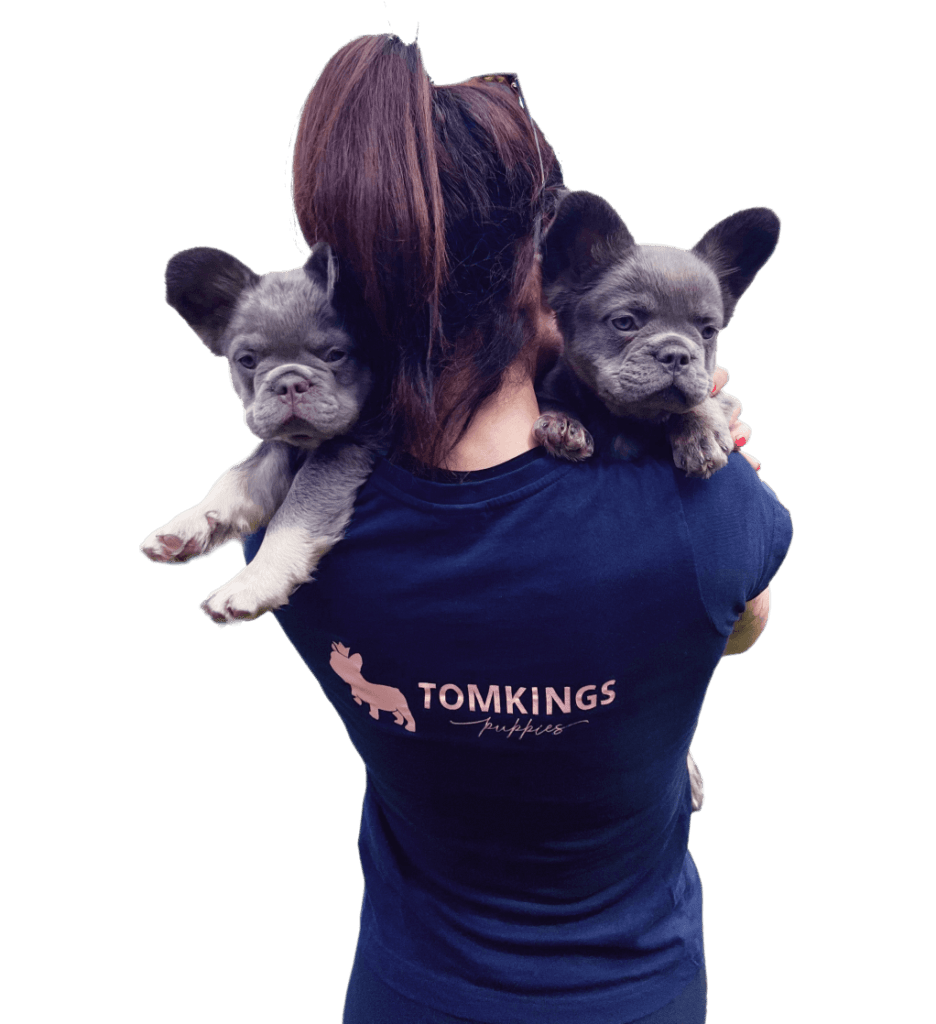Are you looking for the best Frenchie harness, but feel overwhelmed with the myriad of choices on the market? In this article we’ll walk you through various harness types, highlight essential factors to consider when making your choice, and provide insights into harness training for Frenchies. Whether you’re a new Frenchie parent or looking to upgrade your pup’s gear, get ready to make an informed decision that keeps your furry friend both stylish and comfortable on their daily outings.
Table of Contents
ToggleWhy a Comfortable and Safe Harness Is So Important
French Bulldogs, with their distinctive physique, require special consideration when it comes to harnesses. Their unique body shape, characterized by a stout build and a larger head, makes it challenging to find the right fit among the myriad harness options available. Ill-fitting harnesses can cause discomfort, restrict movement, and potentially harm your Frenchie’s sensitive skin.
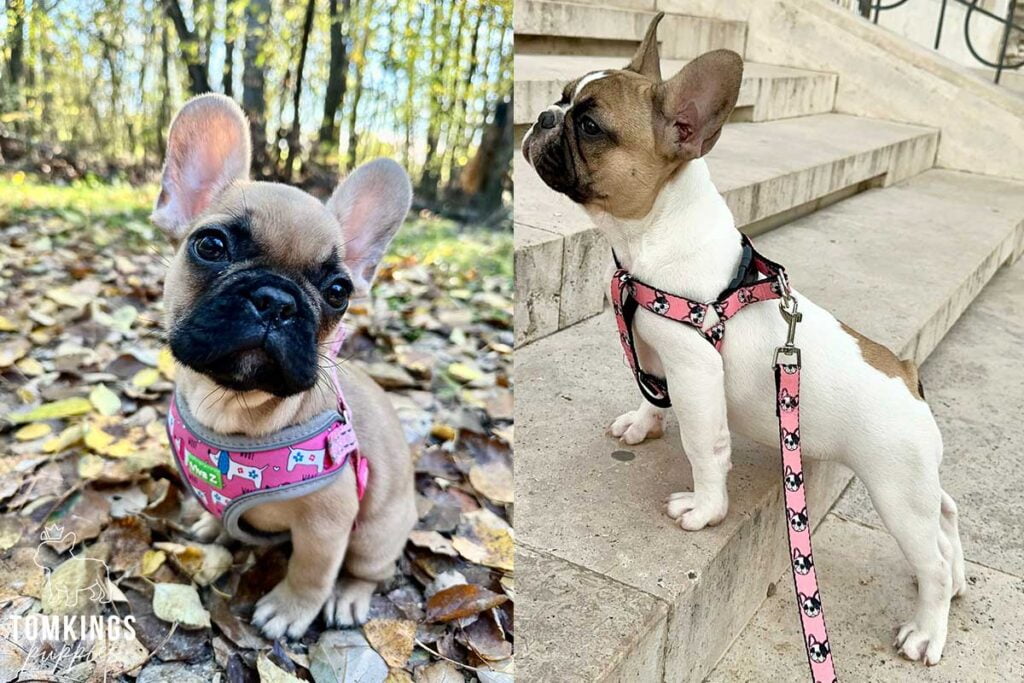

Moreover, these adorable companions have a tendency to overheat due to their brachycephalic (flat-faced) structure. So, selecting a harness that allows airflow and doesn’t add unnecessary warmth is vital. Ensuring breathability in the harness material can prevent your Frenchie from feeling stifled, especially during those playful walks or when exploring the outdoors.
Notably, not all harness designs are suitable for French Bulldogs. Harnesses with straps that may constrict their chest or neck areas can exacerbate potential breathing difficulties common in this breed. This emphasizes the importance of choosing a harness specifically crafted to accommodate their unique physique, ensuring both comfort and safety.


Ultimate Guide
to Raising a Frenchie
Remember, the right harness isn’t just an accessory – it’s an essential part of your Frenchie’s daily comfort and safety routine. Let’s explore the various harness options tailored for French Bulldogs to ensure your furry companion enjoys their adventures without any discomfort or compromise on safety.
Types of Harnesses for French Bulldogs
When it comes to choosing a harness for your French Bulldog, the options can seem overwhelming. Each type offers its unique benefits, but the perfect harness for your furry friend will depend on their individual preferences and your specific requirements. Let’s break down the various types, each with its own set of pros and cons, to help you find the perfect fit for your furry friend!
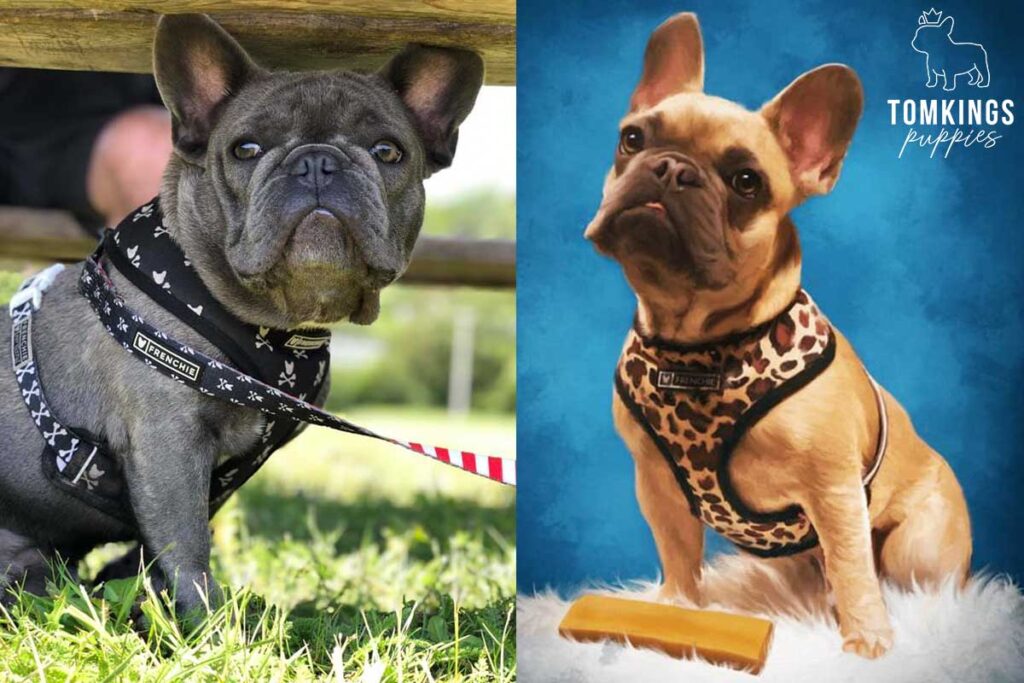

Adjustable Harness


Offering versatility, the adjustable harness can accommodate your Frenchie’s changing body size. It provides room for growth and ensures a snug fit, but some designs may have multiple buckles that could become bulky or cause chafing.
- Pros: Customizable fit for growing Frenchies.
- Cons: Multiple buckles might be inconvenient or cause chafing.
Step-in Harness
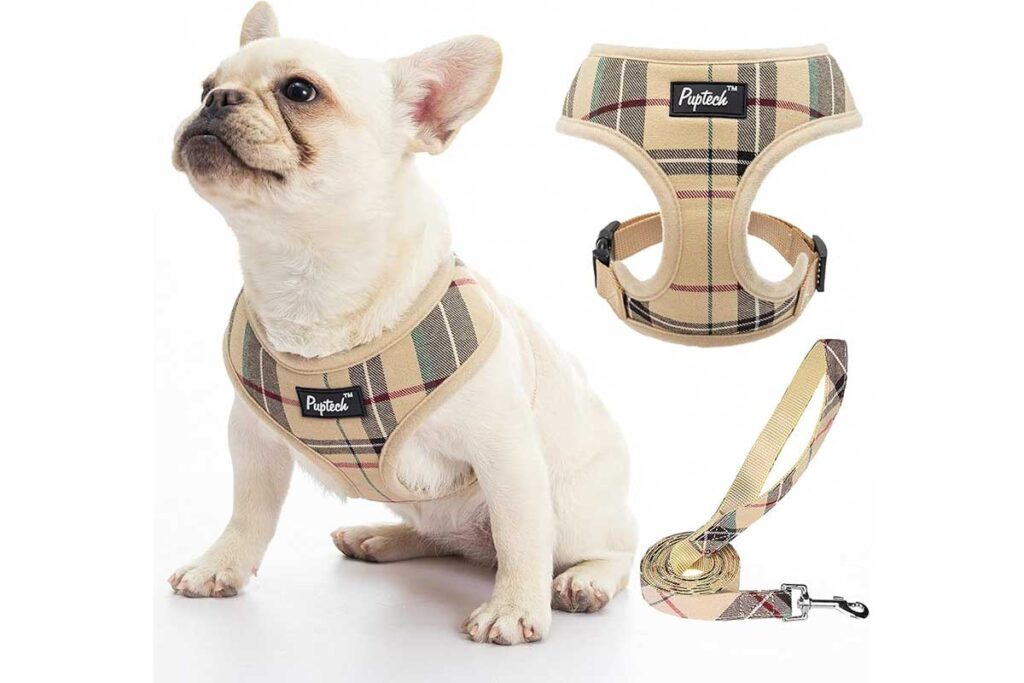

Ideal for Frenchies with larger heads, the step-in harness offers convenience in wearing and removing. Pros include ease of use, but some may find that it lacks adjustability and may not fit all body shapes perfectly.
- Pros: Easy to put on for Frenchies with larger heads. Straightforward to wear and remove.
- Cons: Limited adjustability may not provide an optimal fit for all body shapes.
Mesh Harness
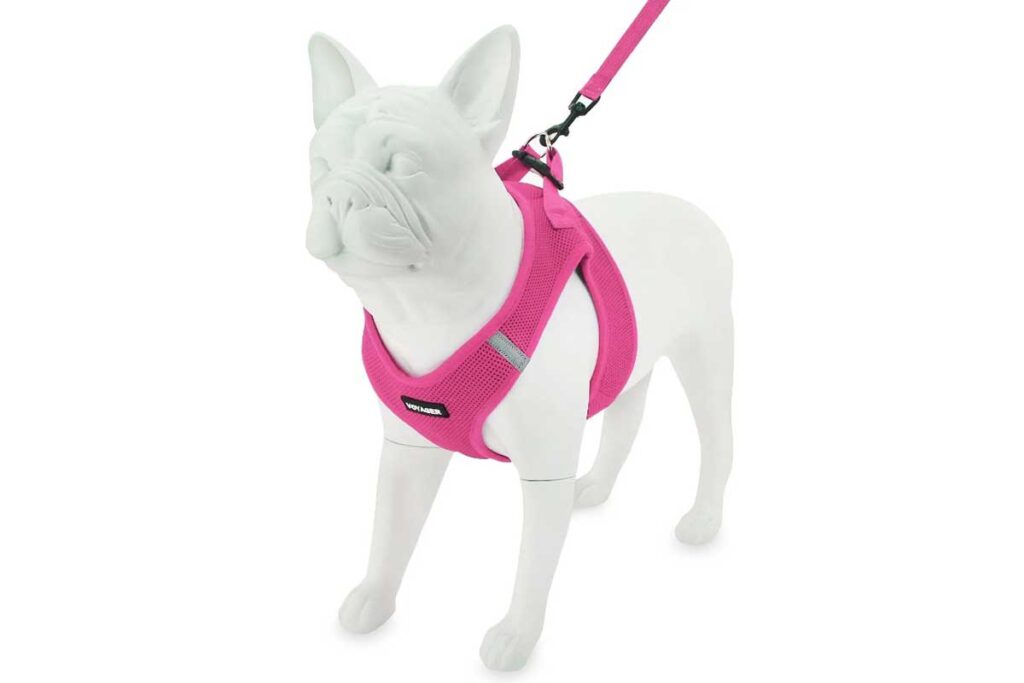

Made from a soft, breathable fabric, the mesh harness ensures comfort, while its lightweight nature allows for airflow, preventing overheating. However, while comfortable, some mesh harnesses might not withstand heavy pulling due to their delicate material.
- Pros: Soft and breathable material ideal even in warmer weather.
- Cons: May not be durable against strong pulling.
Strap Harness


Characterized by its lightweight design and minimal material, the strap harness, often in a Y-shape, allows for free movement. Its simplicity offers comfort, but some might find it lacks padding, potentially causing discomfort during extended wear.
- Pros: Lightweight design allows for freedom of movement.
- Cons: May lack padding and durability for longer walks.
Vest Harness


Perfect for walking in colder weather, the vest harness provides additional coverage and warmth. Its cozy design offers comfort during chilly walks but might be too insulating during warmer seasons.
- Pros: Provides warmth and coverage during colder weather.
- Cons: May be too warm for hotter climates.
Front-Clip Harness (No-Pull Harness)


Featuring a D-ring at the front, this harness discourages pulling during walks by redirecting your Frenchie’s movement. It aids in training but some might find it restrictive.
- Pros: Helps in training by discouraging pulling.
- Cons: Might be restrictive for some dogs.


Subscribe to our weekly blog newsletter
Back-Clip Harness
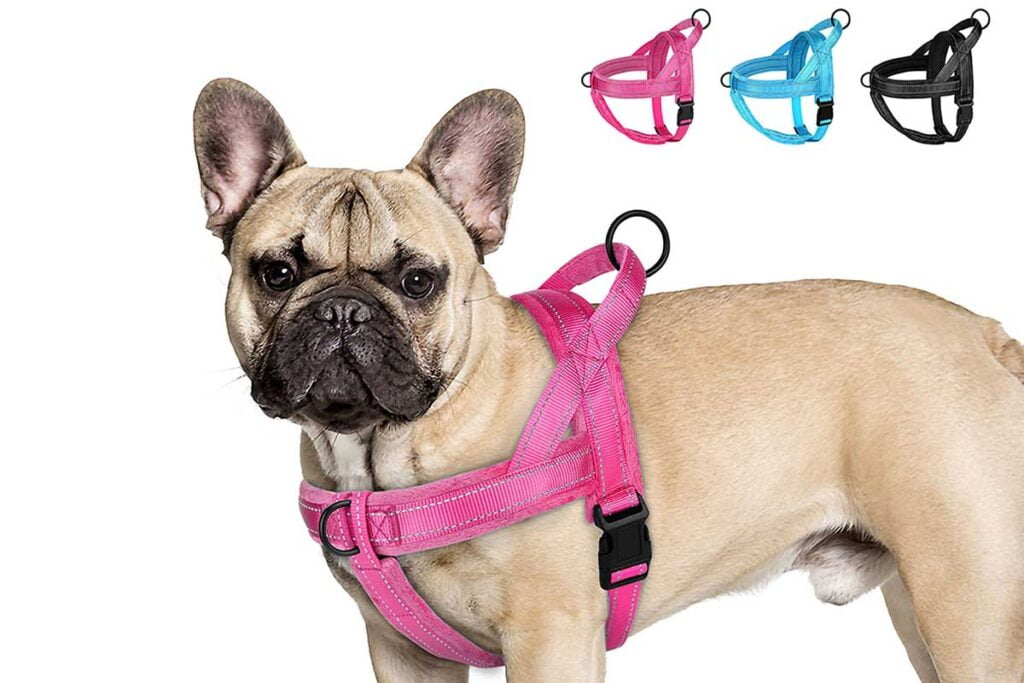

With the attachment point situated on the back, this harness offers simplicity and might be more comfortable for Frenchies sensitive to pressure on their chest. However, it may encourage pulling and might not deter strong pullers.
- Pros: Simple design; comfortable for dogs sensitive to chest pressure.
- Cons: May encourage pulling behavior.
Car Harnesses
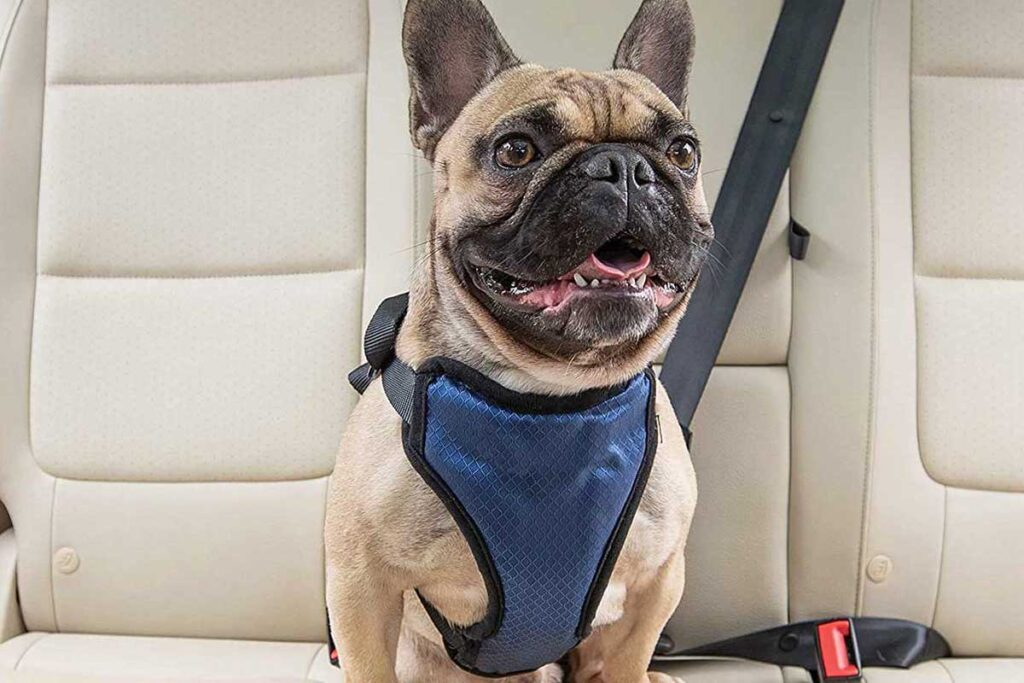

Specifically designed for car safety, these harnesses secure your Frenchie during car rides. They prevent distractions and ensure your pet’s safety during travel, but keep in mind that not all car harnesses are crash-tested, so choosing a reliable one is crucial.
- Pros: Ensures safety during car rides.
- Cons: May not be suitable for regular walks due to their specialized design.
Things to Consider When You’re After the Perfect Frenchie Harness
Selecting the ideal harness for your French Bulldog involves considering various factors to ensure they feel comfortable, safe and stylish during their daily adventures. Here’s what you should keep in mind when embarking on the hunt for the perfect harness!
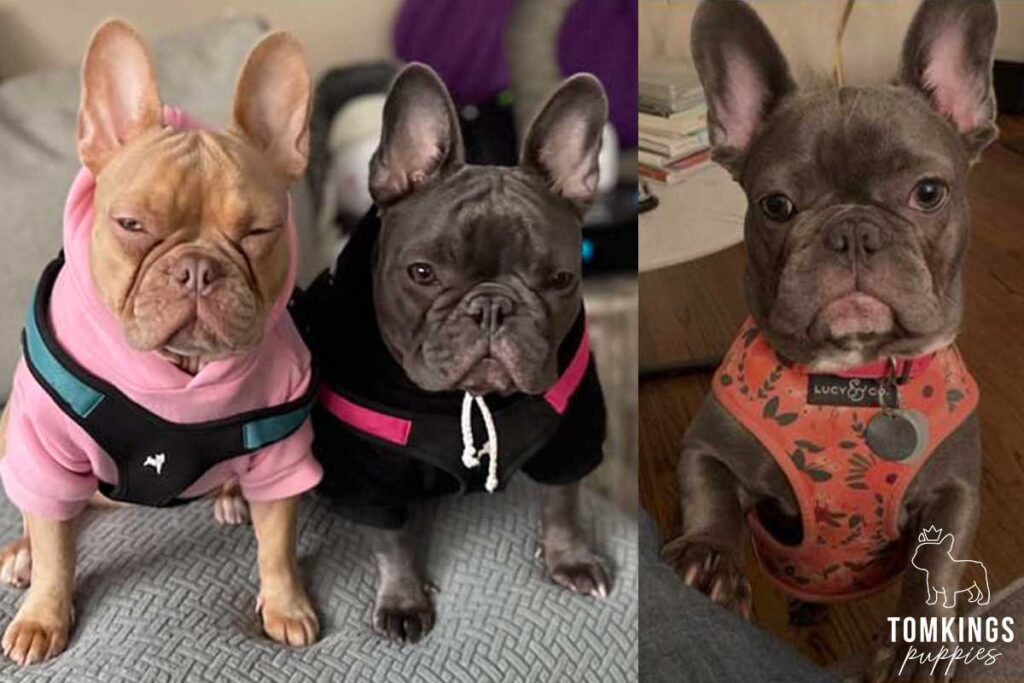

Size and Adjustability
It’s all about the right fit! The harness should neither be too loose, risking slippage, nor too tight, potentially causing discomfort or chafing. Make sure to follow the manufacturer’s size guides to find the perfect fit. Opt for harnesses with adjustable straps, allowing flexibility as your Frenchie grows or for accommodating different body shapes.
Comfort
Look for a harness that prioritizes your Frenchie’s comfort. Padded designs can prevent rubbing and discomfort during extended wear, especially around sensitive areas like the chest, stomach and armpits. A low neckline helps alleviate pressure on the neck area, ensuring your Frenchie’s comfort.
Material
Choose a harness made from robust, durable materials capable of withstanding wear and tear, especially for active Frenchies. Seek out breathable fabrics that promote airflow, preventing overheating which is a common concern for these adorable squish-faced pups. Lightweight materials ensure ease of movement without burdening your furry friend.
Color
Harnesses are not just functional; they’re also a fashion statement! Explore various designs and colors that reflect your Frenchie’s personality. From vibrant hues to trendy patterns, let your pup’s style shine through.
Price
Consider the harness’s value concerning its price. Cheaper options might suit puppies that quickly outgrow their gear. Investing in a more durable, higher-quality harness for a full-grown Frenchie could be more cost-effective in the long run.
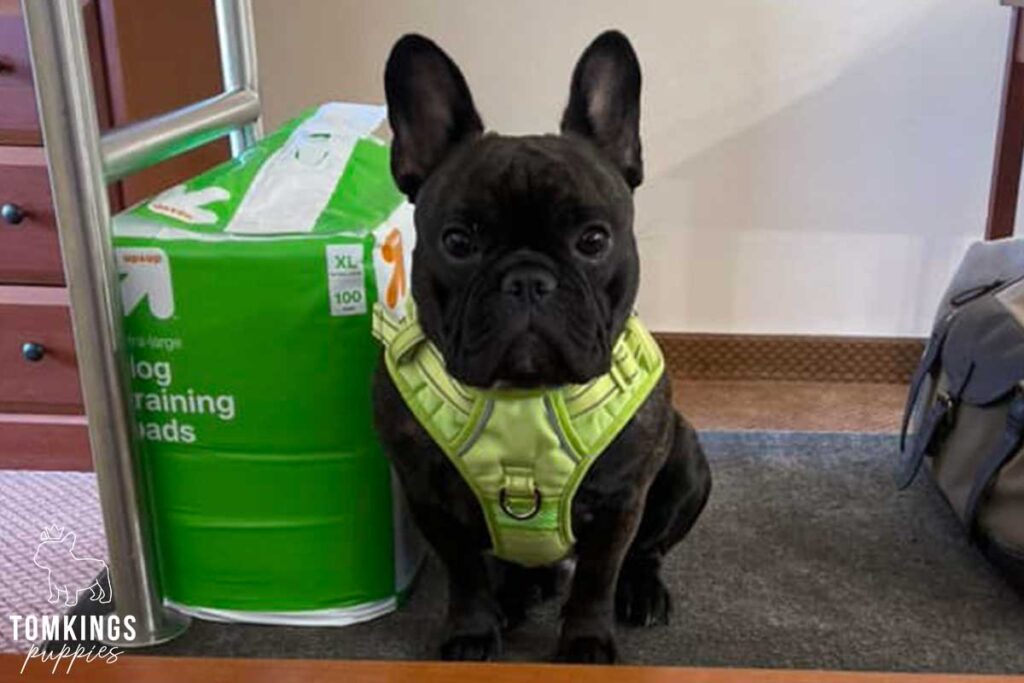

Harness Training for Frenchies
Introducing your French Bulldog to a harness should be a gradual and positive experience. Begin training your Frenchie in a relaxed setting in your home and use treats or praise to create a positive association. Here’s how you should do it step-by-step:
1. Familiarization: Start by placing the harness near your Frenchie during playtime or mealtime. Let them sniff it, associating it with positive experiences.
2. Slow Introduction: Next, gently drape the harness over your Frenchie’s back without fastening it. Offer treats or praise to create a positive association with the harness.
3. Step-by-Step Fitting: Once your Frenchie is comfortable with the harness touching their body, begin securing it for short intervals. Ensure it’s snug but not too tight. Reward them for staying calm and relaxed.
4. Gradual Wear: Increase the duration of harness wear gradually. Engage them in activities they enjoy while wearing the harness to distract from any initial discomfort.
5. Positive Reinforcement: Throughout the process, use positive reinforcement—treats, praise, and play—to create a positive connection between the harness and enjoyable experiences.
6. Practice Makes Perfect: Practice putting on and removing the harness regularly to normalize the process. Make it a part of their routine so they associate it with daily activities.
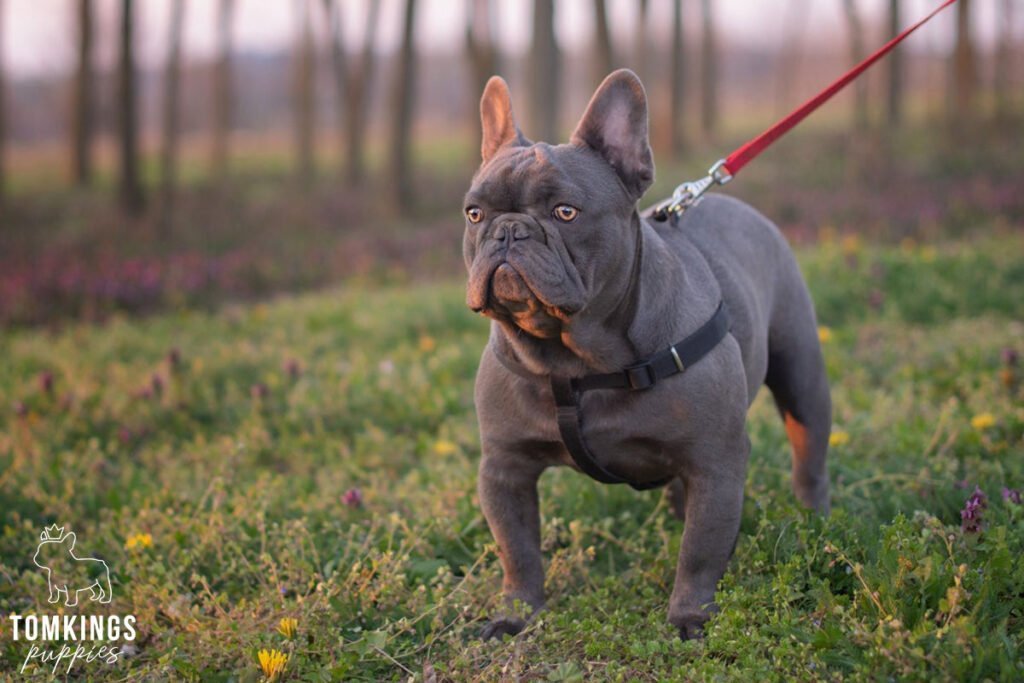

Harness or Collar: Which Is Better?
While traditional collars have been favored for training purposes by many trainers, they might not be the best option for Frenchies. Collars, when pulled too tightly, can put pressure on the neck, potentially blocking the windpipe, especially during walks or if your Frenchie tends to pull. This can be a concern for breeds that may be prone to breathing difficulties.
On the other hand, harnesses may offer a safer and more comfortable alternative for Frenchies, distributing the pressure across the chest and back rather than concentrating it on the neck. This minimizes strain on sensitive areas, reducing the risk of discomfort associated with collars.
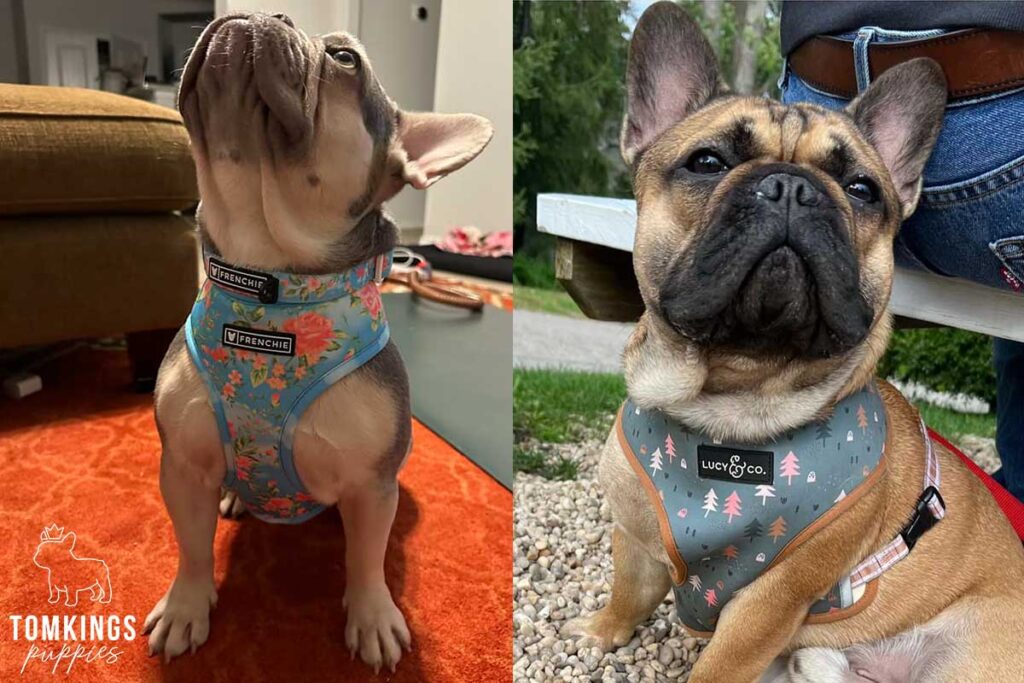

So, while collars might have their place in leash training, when it comes to daily walks and ensuring your Frenchie’s comfort and safety, a well-fitted harness is the better choice.
If you’d like to learn more about Frenchies, join our Facebook group called TomKings Frenchie Family and read our Frenchie parents’ experiences with harnesses.
You can also visit our webshop to find some great leashes, collars and harnesses from Chewy that we recommend for your puppy!
The article is based on the expert knowledge of the TomKings Puppies team who have been breeding French Bulldogs for 10 years on their farm. All the pictures in the post belong to them and their customers, and show puppies from their breed. Check their available French Bulldog puppies, or if you have any questions or comments let us know below the article.




















